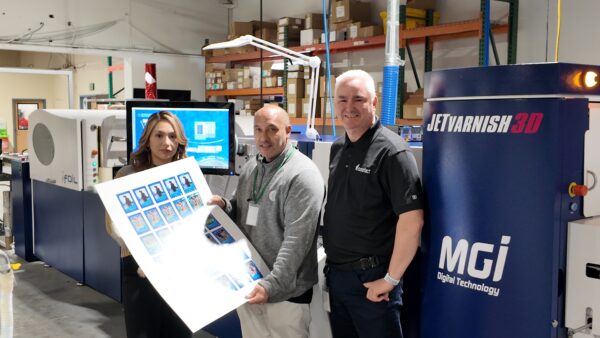It’s time for the office technology industry to embrace the new and add the “Buy Now” e-commerce button.
Malcolm Gladwell’s nonfiction book The Tipping Point was one of the first big bestsellers of the 21st century. It tried to explain change as a concept. Specifically, he detailed that what makes change so hard is that we don’t usually see it coming; change happens slowly until it happens all at once. According to Gladwell, for a long time, change is something that will happen “someday,” and then one day, “someday” is today. And that someday is today for e-commerce.
Stewart Reynolds, the chief operating officer of Shopblocks, an e-commerce platform developer, laid it out plainly in a panel discussion on e-commerce at the 2023 Executive Connection Summit (ECS). “Sixty percent of buying decisions are now made by millennials or younger [generations]. Whether your industry likes it or not, the people now making those buying decisions are going to insist on those platforms, those marketplaces, that technology that they can use.”
This is a fact that Jose Estébanez, vice president of corporate marketing at Kyocera Document Solutions America, has already accepted. “There’s an audience out there that doesn’t want to talk to a sales rep, [like] a younger generation starting small businesses. That’s the first reality that we, as manufacturers and dealers, have to face. We have to understand that there’s an opportunity for us to offer something unique to these customers. If we don’t, others will.”
Young buyers don’t want to flip through paper catalogs and listen to sales pitches over rounds of golf. They already know what the sales rep is going to say. They Googled it.
Tim Renegar, president of Kelly Office Solutions, had the hard numbers, which he shared during the ECS e-commerce panel. “Eighty percent of people will go on a website three to five times, without you knowing it before they buy.” And nearly seventy percent of those web browsers are millennials. Renegar admitted that was “a tough pill to swallow,” which is why his dealership has added an e-commerce component to its website. “I was in that point of view of my sales guys know everything going on in this industry. I’m here to tell you that they don’t.”
Today’s customers do their own research, comparison shop, and talk to other buyers. What dealers may see as protecting their sales staff, protecting their margins, and making sure they can compete on quality and not just on price, and to a millennial or a Gen Z (Yes, a lot of them are out of college now, and they’re looking at your company’s website right now), those efforts just look like an obstacle in their path— an obstacle the competition may already have removed.
“As consumers, especially because of the pandemic, we have gotten accustomed, and frankly, we now expect, to access the things we want online,” said Tawnya Stone, vice president of strategic technology at GreatAmerica Financial Services, during the ECS e-commerce discussion. “That has translated to the B2B world, where people are starting to expect that same level of availability.”
Velinda Cox, Konica Minolta’s senior vice president of e-commerce, sees fresh territory in the always-on digital sales world. “In the past, our only touchpoint with a customer was service or sales or if you had a billing problem. Sales have great relationships when they’re selling, but then there are long periods of time where they may not contact the customer,” she said. “With a digital ecosystem approach, you can touch at any time. Evenings, weekends, periods of time that we never worked before, but the buyers are sitting there researching, trying to solve business problems.”
Of course, launching a new sales pipeline is never easy or fast, but the industry thought leaders touting e-commerce estimate that it could be done at a cost in the low six figures and a timeline on the scale of months rather than years. Manufacturers are investing more in web-friendly sales assets such as animated product tours or digital catalogs, and even training videos. But for many dealers, it’s not practical considerations holding them back from e-commerce but persistent misconceptions.
“Sales reps see e-commerce as an enemy because they think it’s going to take out part of their business, but that’s not true,” said Kyocera’s Estébanez.
“This industry has been very conservative,” said Victor Jacksier, senior product manager at Keypoint Intelligence. “Even today, if you talk to dealers about e-commerce, the first concern they have is, ‘Oh no, one of my competitors is going to see my pricing.’ Newsflash: They already have your pricing.”
Estébanez sees the opportunity in that. “The user always wants the price. If you show the price, you become an honest company. You become more trustworthy, allowing you to do more than just a transaction. A price can act like a magnet for users to request something else.”
Jacksier added that making pricing info available is not as big of a deal as dealers think. He sees two ways of looking at sales: They either come from relationships, or they don’t. Not everything does, and that’s fine. “Your lower profit products, your easier products probably don’t need an interaction, so sell all of that stuff online and focus your sales reps on the higher-end stuff because that’s where your customer needs help, and that’s where your margins are,” he said.
“We are absolutely counting on it being a device that makes us very transparent to our customers,” emphasized Kelly Office Solutions’ Renegar at ECS. “It’s a different way to market that they’ve not been used to in our industry. It allows them to buy in a way that they’re comfortable with buying already. We’re at least researching and finding out the information they want. If they want to take it to the end, we’ll take it to the end.”
A well-designed e-commerce platform can take a lot of the risk and almost all of the drudgery out of selling. Instead of the grind of outbound sales, customers generate their own leads, with the website gathering valuable information about their needs and budget before a sales rep even reaches out.
This is a sometimes-overlooked benefit of e-commerce that Anthony Sci, chief operating officer at Keypoint Intelligence, emphasized at ECS. “You’re collecting a lot of data. Who’s on your website? You’re finding that out. What are they looking at? What are they shopping for? What are their buying signals?”
These benefits build on themselves, so getting started quickly is the most important thing. GreatAmerica’s Stone advises delaying the big marketing push a new e-commerce needs for a full launch and developing a smaller test version, perhaps aimed at a certain segment of customers.
“Start something and then tweak based on what’s going well, what’s not going well,” Stone advised. “You’re not going to know if any of these things are working until you’ve tried them.”
_________________________
To become a subscriber, visit www.thecannatareport.com/register or contact cjcannata@cannatareport.com directly. Bulk subscription rates are also available upon request and included in our media kit.





